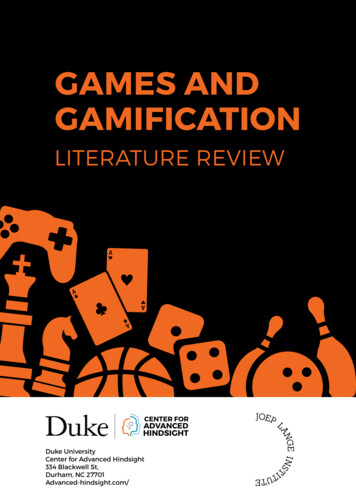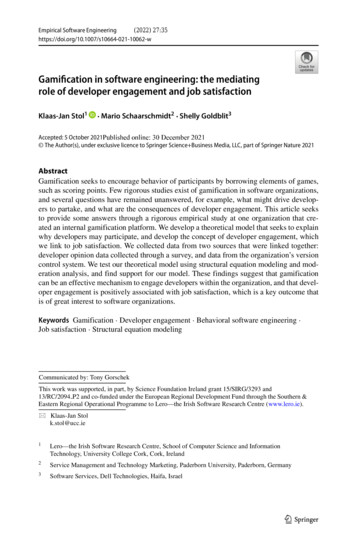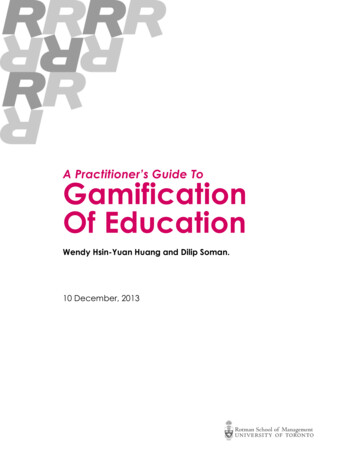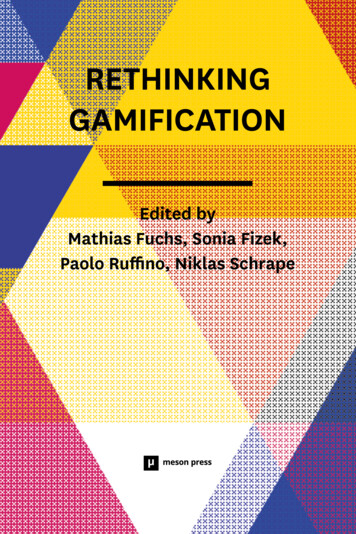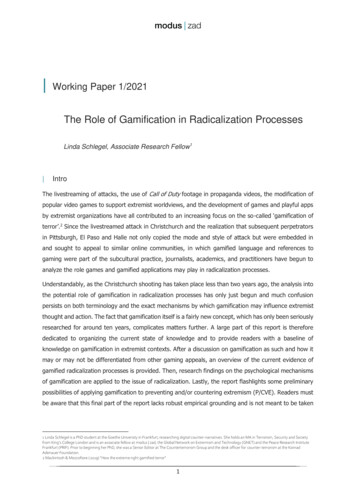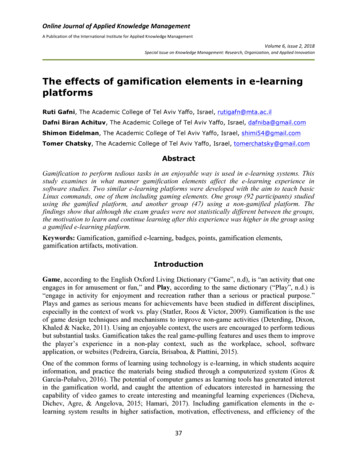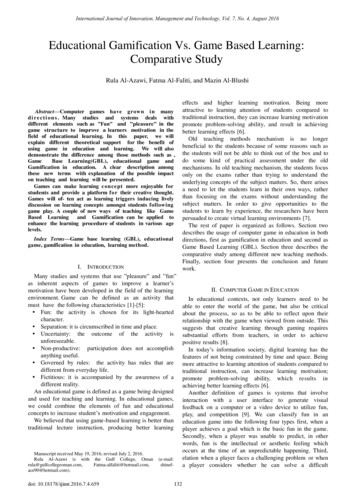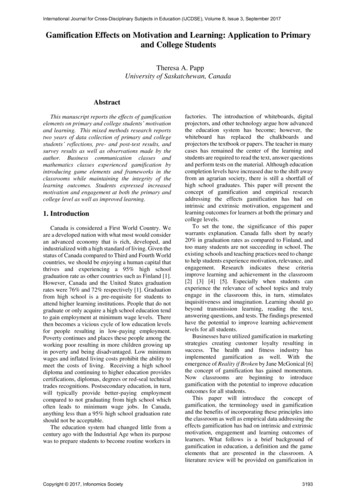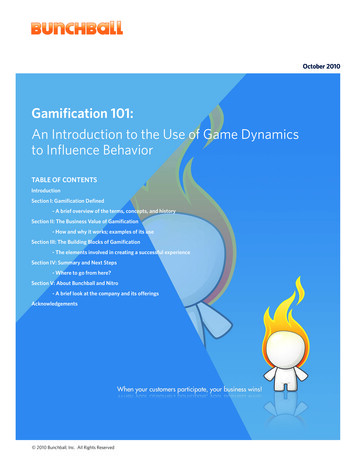
Transcription
Analysis of Gamification in EducationAndrew Stott and Carman NeustaedterSchool of Interactive Arts and Technology, Simon Fraser University250 – 13450 102nd AvenueSurrey, BC, Canada, V3T 0A3[ads9,carman neustaedter]@sfu.caABSTRACT / INTRODUCTIONGamification refers to the application of game dynamics,mechanics, and frameworks into non-game settings. Manyeducators have attempted, with varying degrees of success,to effectively utilize game dynamics to increase studentmotivation and achievement in the classroom. In an effortto better understand how gamification can effectively beutilized to this end, presented here is a review of existingliterature on the subject as well as a case study on threedifferent applications of gamification in the post-secondarysetting. This analysis reveals that the underlying dynamicsthat make games engaging are largely already recognizedand utilized in modern pedagogical practices, althoughunder different designations. This provides some legitimacyto a practice that is sometimes dismissed as superficial, andalso provides a way of formulating useful guidelines forthose wishing to utilize the power of games to motivatestudent achievement.RELATED WORKThe first step of this study was to review literature relatedto the use of gamification in education. This wasundertaken in order to inform the subsequent case studies.Several works were reviewed with the intention of findingspecific game dynamics that were met with a certain degreeof success across a number of circumstances.To begin, Jill Laster [10] provides a brief summary of theearly findings of Lee Sheldon, an assistant professor atIndiana University at Bloomington and the author of TheMultiplayer Classroom: Designing Coursework as a Game[16]. Here, Sheldon reports that the gamification of hisclass on multiplayer game design at Indiana University atBloomington in 2010 was a success, with the average gradejumping a full letter grade from the previous year [10].Sheldon gamified his class by renaming the performance ofpresentations as 'completing quests', taking tests as 'fightingmonsters', writing papers as 'crafting', and receiving lettergrades as 'gaining experience points'. In particular, he notesthat changing the language around grades celebrates gettingthings right rather than punishing getting things wrong [10].Although this is plausible, this example is included herefirst because it points to the common conception of whatgamifying a classroom means: implementing gamecomponents by simply trading out the parlance of pedagogyfor that of gaming culture.Although its intentions are good, it is this reduction of gamedesign to its surface characteristics that Elizabeth Lawleywarns is detrimental to the successful gamification of aclassroom [5]. Lawley, a professor of interactive games andmedia at the Rochester Institute of Technology (RIT), notesthat when implemented properly, "gamification can helpenrich educational experiences in a way that students willrecognize and respond to" [5]. However, she warns thatreducing the complexity of well designed games to theirsurface elements (i.e. badges and experience points) fallsshort of engaging students. She continues further,suggesting that beyond failing to engage, limiting theimplementation of game dynamics to just the surfacecharacteristics can actually damage existing interest andengagement [5]. Lawley is not suggesting that gameelements should be avoided, but rather she is stressing theimportance of allowing them to surface as part of a deeperimplementation that includes the underlying foundations ofgood game design.Upon reviewing the available literature, certain underlyingdynamics and concepts found in game design are shown tobe more consistently successful than others when applied tolearning environments, these are:ooooFreedom to FailRapid FeedbackProgressionStorytellingFreedom to FailGame design often encourages players to experimentwithout fear of causing irreversible damage by giving themmultiple lives, or allowing them to start again at the mostrecent 'checkpoint'. Incorporating this 'freedom to fail' intoclassroom design is noted to be an effective dynamic inincreasing student engagement [7,9,11,15].If students are encouraged to take risks and experiment, thefocus is taken away from final results and re-centered onthe process of learning instead. The effectiveness of thischange in focus is recognized in modern pedagogy asshown in the increased use of formative assessment. Likethe game dynamic of having the 'freedom to fail', formativeassessment focuses on the process of learning rather thanthe end result by using assessment to inform subsequentlessons and separating assessment from grades wheneverpossible [17]. This can mean that the student is usingongoing self assessment, or that the teacher is using1
ongoing assessment to inform their teaching or illustrate apoint; all while eschewing concrete grades much of thetime.As Kapp notes, this doesn't mean letting students have fourchances at a multiple choice question with four possibleanswers. What it means is "encouraging learners to explorecontent, take chances with their decision making, and beexposed to realistic consequences for making a wrong orpoor decision" [9]. In line with the formative assessmentmodel, this means incorporating student assessment thathighlights useful lessons taught through the experiencewhile subduing indelible marks or grades. Joey Lee andJessica Hammer of Columbia University encourageteachers to "maintain this positive relationship with failureby making feedback cycles rapid and keeping the stakeslow" [11]. This points to the next game dynamic of rapidfeedback.Rapid FeedbackAs Kapp notes, "feedback is a critical element in learning.The more frequent and targeted the feedback, the moreeffective the learning" [9]. Frequent targeted feedback ishighly prevalent in game design. James Gee notes that,"level design ensures players get lots of practice applyingwhat they have learned [.] feedback is given moment bymoment, and often summarily at the end of a level or inboss battles, which require players to integrate many of theseparate skills they have picked up in prior battles withlesser enemies" [7].Of course feedback is already a key element in educationeven without any attempts to integrate game design, butKapp notes that educators can increase feedbackmechanisms by harnessing elements of game designthrough "continual feedback to learners in the form of selfpaced exercises, visual cues, frequent question-and-answeractivities, a progress bar, or carefully placed comments bynon-player characters [9]. The mention of a progress barprovides a good segue to the next game dynamic:progression.ProgressionProgression is seen throughout game design in the form oflevels or missions. It is recognized in modern pedagogy asscaffolded instruction [8]. Beth Kemp Benson describesscaffolded learning as framing, guiding, and supportingstudents by organizing information into categories in orderto focus attention. She notes that "this can eliminate orreduce the I-don't-know-how-to-get-started problem andallow the student to restart if he or she gets stopped orstumped" [2]. This speaks to 'the freedom to fail' dynamicmentioned previously, and mirrors the effectiveness of'levels' in game design.Progression can also be linked to the game dynamics of'the interest curve' [9] and 'just in time teaching' [7,16].The idea of the interest curve is that by purposefullysequencing events in a particular order, engagement isincreased. For instance, when seeking to engage anaudience, such as in public speaking or film, it is importantto begin with a highly interesting element so as to grab theaudience's attention. Further, it is important to grabattention at certain points so as not to lose their attention.These high and low points create a sequence known as aninterest curve. Just in time teaching refers to the process ofgathering assessment immediately prior to a lesson, so asto tailor the lesson to the specific needs of the students atthat particular time. By consistently touching on pointsthat are most relevant to the audience at the time of thelesson, not only is engagement increased, but students arebetter equipped with the tools to succeed. Kapp notes thatthese dynamics are effective because they "purposefullysequence events within the flow of the entire game tocontinually grab and hold the player's attention” [9].Connie Hackathorn and Max Lieberman, two graduatestudents at The University of Arizona, found progressionto be useful in their gamification of Prof. Wayne Brent'sUniversity of Arizona course Teaching With Technology[16]. Hackathorn and Lieberman used Bloom's taxonomy[3] as a guide in designing the course. Bloom's Taxonomyis a well established classification model of the differentlearning objectives that educators set for students. Thereare many objectives, ranging from remembering facts toanalyzing and applying concepts and making connectionsbetween concepts.Hackathorn and Lieberman used Bloom's Taxonomy as aguide in designing the progression of the course whichrequired students to complete a level or assignmentsatisfactorily before being able to progress to the next.They did this by incorporating lower order thinking skillsinto the first stages (identifying, remembering,understanding), progressing to higher order thinking skillsin subsequent levels (analyzing, evaluating, critiquing,summarizing) and finally arriving at the highest orderthinking skills in the final levels (composing, creating,designing, planning, inventing) [16]. This is an intelligentdesign because the students will need the knowledge theygained in earlier stages to successfully complete the higherlevels. As noted by Gee previously, this a key element ingames that requires "players to integrate many of theseparate skills they have picked up in prior battles withlesser enemies" [7] and apply them to 'boss battles'.StorytellingAnother aspect of game design that can positively impactlearning in the classroom is the use of storytelling andnarrative. As Kapp notes, most games employ some typeof story. SimCity tells the story of building a city from theground up, Monopoly tells the story of becoming richthrough property ownership at the risk of losing it all [9].He also notes that "people learn facts better when the factsare embedded in a story rather than in a bulleted list" [9],and provides a good example of how even a simpleintegration of storytelling can be utilized to good effect.2
His example begins with a class that unfolds in a typicalmatter, with the introduction of terminology followed byan explanation of concepts, a description of a model andcase study, and finally a quiz. He then offers an exampleof how the use of storytelling might change how the yinghesuspectsaco- ‐workerhasembezzled tpartofthestory."[9]Providing a unifying story throughout a curriculum can putthe learning elements into a realistic context in whichactions and tasks can be practiced, something that isconsidered extremely effective in increasing studentengagement and motivation [6,9,15].These game dynamics of the Freedom to Fail, RapidFeedback, Progression, and Storytelling are elements thatan educator interested in harnessing the effectiveness ofgames would be smart to focus on as they are shown to begrounded in proven pedagogical practices. Therefore, theyare brought forward here as a way of performing thefollowing case studies.CASE STUDIESThese case studies evaluate the effectiveness ofgamification in three instances of gamified educationalendeavors in order to identify key aspects and provide someguidelines for best practice. This was done by reviewingcourse web pages, journal submissions, video interviews,online articles, and student work. For Case Study 3,discussions with the course instructor, as well as a reviewof previous iterations of the course, were undertaken aswell.This study was done through the lens of the literaturereview; the four dynamics and concepts mentionedpreviously (Freedom to Fail, Rapid Feedback, Progression,Storytelling) were used as a framework for evaluating thesethree cases. In some instances these concepts arerecognized verbatim, in other cases where a similar conceptis discussed under a different guise, the parallel conceptwill be noted in parentheses. During this study, othergaming dynamics and concepts were uncovered and areincluded here as well.CASE 1: INTRO TO INFORMATION STUDIESProfessor Clifford Lampe is an Assistant Professor at theSchool of Information at the University of Michigan.Lampe utilizes gamification principles in his 200-studentlecture class titled UMSI 110 - Introduction to InformationStudies. Lampe identifies four elements of gaming inparticular as being effective in his classes: Choice (Freedomto Fail), Rapid Feedback, Collaborative Processes, andCompetition [14].Evidence of Choice (Freedom to Fail)Lampe notes that one of the most effective attributes forengagement in video games is that users get to choose theirpath through the game. He integrates this feature into hisclass by allowing students options for how to play out theirassignments. At the beginning of the semester, studentscreate a 'quest log' which requires them to select which ofthe possible future quests they will be more likely toparticipate in. Students are able to drop quests that they arenot interested in. Further, Lampe also integrates the'leveling' of assignments, where a higher level assignment isnot available to the student until it has been 'unlocked' bycompleting a lower level assignment [14].Evidence of Rapid FeedbackLampe states that he has mechanisms built in to the classthat give students rapid feedback, however it is unclearwhat these are. He does note that providing rapid feedbackand having such a wide variety of assignments causes alarge increase in work load for both himself and theteaching assistants. To combat this, he has one TAdedicated to making sure that the students have theirassignments and know what quests they are participating in,and that feedback is given in a timely fashion. This TA iscalled the "grades master", and their role as full timefeedback assistant is integral to having feedbackmechanisms working efficiently enough to reflect gamingfeedback sufficiently [14]. This is problematic for typicalteaching situations where such a resource is not available.Lampe also notes that feedback from students, particularlycourse feedback, is increased as a result of the playfulatmosphere that gamifying a classroom causes. It seemsstudents are less timid to be a part of the improvementprocess because the course is transparently experimental[14].Evidence of Collaborative ProcessesCollaboration is heavily embedded in the course. Lampe'sstudents participate in guilds and guild quests, whichencourages peer collaboration. Based on limitedinformation, it is difficult to decipher whether or not this issimply a renaming of group work. What is clear is that theguild is the same group throughout the semester, theyparticipate in all discussions together, and they produce ateam assignment once in the semester [14].3
Evidence of CompetitionLampe integrates Live Action Role Play (LARP) into thecurriculum. He goes so far as to have students dress up as acharacter of their choice and 'battle' in class against oneanother, showcasing their knowledge of different conceptscovered in the course (Fig. 1).Fig. 1The 'head-to-head' nature of this role play element relies oncompetition as a key motivator. It also provides studentswith a valuable alternative way to showcase theircomprehension [14]. Lampe notes that the students react indifferent ways to this element of the course. There are thosewho feel that it is cheesy at best, and at its worstcondescending. However, Lampe notes that the vastmajority of students are happy to have anythingimplemented that cuts down on the 3 hours of 'being talkedat' that they are accustomed to. This speaks to theimportance of differentiated instruction. Especially in aclass of this size, it is impossible to please every studentwith every lesson all of the time. However, by utilizing avariety of techniques, not relying too heavily on any onestyle, and being flexible enough to tweak things whennecessary, experimental techniques can be implementedwith less risk and more investment from students.Taking chances is what learning is all about, and if theimplementation of these techniques is being driven by thedesire to make a better learning environment, students willpick up on that and student investment will increase. Withthis in mind, it is important then to see and convey that thecourse design is an iterative process, something that reliesheavily on the ability to collect and implement feedbackfrom students.CASE 2: JUST PRESS PLAYJust Press Play (JPP) is a real world game developed at theRochester Institute of Technology (RIT). It is not a specificclass, rather a 'gaming layer' that students engage with inand around their academic classes. It is offered to the morethan 400 students in the School of Interactive Games andMedia at RIT. Rather than focusing specifically onacademic achievement, the game instead encourages thepositive social behaviours that lead to academic success.These include making personal connections with facultyand with students in other years, proposing ideas for coursedesign, attending workshops, and many more. The guidingaim of the game is to increase student engagement inUniversity life for the sake of academic and social success[13].JPP also aims to help students recognize and be recognizedfor their own personal achievements, be it social oracademic, which can in-turn provide them with real worldbenefit as it allows them to show evidence of their learning,skills, and achievements to interested parties, such aspotential employers [13].Fig. 2Achievement cards (Fig. 2) are physical cards, similar insize to trading cards, and are embedded with radiofrequency identification (RFID) and secret codes, whichallow students and/or faculty to record achievements. Theseachievements are then uploaded to the online component ofthe game (Fig. 3) students can track their progress andcompare their success to the community of players.Other FindingsLampe also notes that students appear to retain informationbetter over the long term when it is associated with 'shockvalue'. Because students remember the experience, theyremember much of the information associated with it [14].Fig. 34
Evidence of the 'Freedom to Fail'CASE 3: SPECULATIVE DESIGNThe game has nothing to do with grades, and can be playedby students over their entire career at the University andeven after graduation. By separating the achievements fromgrades, students are free to engage with the game aspects oftheir choosing, without fear of reprimand. This encouragesexploration and risk taking, two elements that effectivelyutilize this key dynamic in game design [13].Dr. Carman Neustaedter is an Assistant Professor at theSchool of Interactive Arts & Technology at Simon FraserUniversity. He utilizes gamification principles in his courseof approximately 70 students titled IAT 431 - SpeculativeDesign. An examination of this class shows evidence ofFreedom to Fail, Rapid Feedback, Progression, andStorytelling to varying degrees.Evidence of Rapid FeedbackEvidence of the 'Freedom to Fail'By utilizing RFID and codes, feedback is instant in the caseof unlocking achievements. Another example of instantfeedback can be seen in the achievements that requirevisiting a professor at their office or going to a conference(Fig. 4). In these cases the student instantly gains thebenefit of beginning a relationship with their professors andnetwork which decreases anxiety in approaching them forsubsequent needs.Evidence of the 'freedom to fail' dynamic is found throughthe emphasis of user feedback and student reflection in thefinal project. By incorporating feedback collection andreflection into the final project design, it is implied that thedesign process is an ongoing cycle, and that errors areuseful (so long as they are reflected upon and utilized forfurther iterations). Language such as 'prototype' and 'lowfidelity' further strengthen this message.Further evidence of the freedom to fail is given in the firstweek 'riddle question' which is transparently separate fromgrading. In the description of the task, it is stated that thefirst week submission is not graded, but feedback is givenso that expectations are clear for subsequent submissions.This appears to be a good balance, as any drop in studentmotivation to complete the task is offset by the benefit ofknowing the marking style of the professor.The case of increased workload often associated withincreased demand for rapid feedback is largely avoidedbecause the work has been done in advance through thedevelopment of the system. It should be noted however,that faculty time is taken up by being available to scancodes and assist players.Neustaedter is considering changing the sequence ofassignments in future semesters in order to incorporatemore of the freedom to fail dynamic. Rather than have thecurriculum work towards a final project, the project wouldbe pushed to the beginning of the course (and the gradeweighting lessened) in an attempt to provide students with aframe of reference for subsequent activities. Subsequentactivities would incorporate reflection and reiteration. Inthis case, the emphasis would be on learning from one'smistakes, therefore incorporating more of the 'freedom tofail' dynamic.Evidence of StorytellingEvidence of Rapid FeedbackJPP includes good use of storytelling. When certainachievements are unlocked, students gain access to moreparts of a fictional 'alternate history of RIT' that describes abattle fought between two rival factions. These rivals arebased on the split between the real world faculties of Artand Engineering. The story represents the need to embraceaspects of both sides in order to achieve mastery.Evidence of rapid feedback in Neustaedter’s course is mostapparent in the use of a course score board (Fig. 5), whichis available to the students through the course website.Fig. 4Evidence of ProgressionJPP has strong evidence of the use of progression. Playersinvolved in JPP 'level up' to unlock new achievements thatwere not previously available. Further, progress is visuallyrepresented, through the online platform, in real time. Onthe online platform, students can also compare theirprogress over time and to other players in the game.The scoreboard shows a ranked-order list with the student'srank highlighted in orange. This scoreboard effectivelyshows the students how they are doing overall. Further, itshows how individual assignments have affected theiroverall score, because they are able to recognize any changein their rank both visually and numerically as a result oftheir latest submission. This ability to see changes visuallyas a result of their work provides an important cause andeffect cue that can lead to increased ownership and sense ofresponsibility.5
has the further benefit of allowing for the 'just in timeteaching' concept discussed earlier. The teacher is able tomodify the day's lesson based on the responses from theriddle questions. If the submissions show significantmisunderstanding on a particular concept, the teacher canchoose to change the focus of the next lesson in order toaddress the issue.Evidence of ProgressionEvidence of progression is most evident in the onlinecourse website. Here students are given visual clues as towhere they are currently situated in the course curriculum(Fig. 6).Fig. 5Also, the use of graded rank titles, such as 'artistic intern' or'grand master speculative designer', ties the course's contentto its broader industry and career connections; somethingthat can also lead to increased motivation.It is important to note that the effectiveness of thisscoreboard is not solely a result of the use of points. HadNeustaedter opted to use the traditional gradingmechanisms of letter grades or percentages, the effect inthis area would likely have been the same. As noted byLawley earlier, it is the underlying dynamics of games thatare effective, not the surface elements. This scoreboarddoes a good job of increasing motivation becauseachievement is tied to future opportunity as much as pastresults. Where a 'B' student might be satisfied with theircurrent mark and leave it at that, a student that is a mere 50XP from the student in front of them might be moremotivated to put in the extra effort on the next assignment.Letter grades seem to imply a certain finality, but the use ofpoints in combination with a feedback mechanism such as ascoreboard imply that making it further up towards the topof the board is often still a possibility. This impliedmessage is given here through the use of a dynamicscoreboard, not the use of points in and of themselves.Fig. 6There is also use of progression evident in the onlinesubmission of weekly 'riddle questions' which students gainaccess to as the weeks progress. These are discussed inmore detail in the next section 'Evidence of Storytelling'.Evidence of StorytellingEvidence of storytelling is apparent in this course in severalways. One is in the form of the student as protagonist,working their way from 'Usability Intern' through 18 otherdesignations before reaching the top designation of 'GrandMaster Speculative Designer'. This provides students with asense that the skills and concepts learned during this coursehave practical use in their future endeavors in the field.Although it has been removed from the course in recentsemesters, Neustaedter had previously incorporatedstorytelling in the course through a kidnapping mystery.This was done using a progression where students weregiven a new clue each time they reached a new XP level.The clue was a keyword that could be entered online toreveal a photograph (Fig. 7).Another important feature is that it also shows their statusin comparison to the other members of the class, sparkinghealthy competition which can lead to increased motivation.Further evidence of rapid feedback is found in that selectedanswers from the weekly 'riddle' questions are showcased inclass. This is an efficient method of providing feedback andFig. 76
These photographic clues eventually pointed to a specificlocation on campus where a business card was hidden thathad the final keyword. When this final keyword wasinputted into the online form, the identity of the kidnapperwould be revealed (Fig. 8).engage, and building game-like interactions on top of those.[4].An educator interested in harnessing the dynamics thatunderlie games would be well served by a focus on thegame dynamics mentioned above (Freedom to Fail, RapidFeedback, Progression, Storytelling) as they are seen toprove successful to some degree throughout the literature.However, the choice of which to employ and which toeschew can only be made by those within this context. Aswas seen in the case studies, methods that may work well inone context are not guaranteed to work well in another.However, one common thread found throughout successfulgame dynamics is that they all work to increase a feeling ofagency and ownership in the user. As Gee notes, "in a videogame, players make things happen; they don't just consumewhat the [game designer] has placed before them [.] theirchoices matter" [6]. What also becomes evident is that theunderlying dynamics that make games engaging are alsorecognized in modern pedagogy, although under differentlabels.Fig. 8Neustaedter notes that he removed this element from thecourse as he suspected that it came across as 'cheesy'. Ifstudents found this element to be cheesy, it was likelybecause the reward of finding the mystery kidnapper wasnot attached to any real benefit like actual underlyinggrades or the unearthing of useful knowledge. The XPpoints were, in the end, attached to real world grades. Thislack of student engagement was also likely because thismystery was too far removed from course content. Thispoints to the important consideration of context whenimplementing game dynamics in an educational setting,which is discussed in the conclusion that follows.Further use of storytelling is evident in that IAT 431requires students to perform a 'real world' implementationof their final project by having them perform a deploymentof their project in a field scenario, much like a professionalspeculative designer would. This incorporation of ascenario-based activity provides a powerful bridge betweenclassroom theory and real world application.CONCLUSIONThese three case studies are useful in seeing how theoretical'best practices' in the gamification of education areextremely context sensitive. There is no once-size-fits allmodel for the successful gamification of a classroom. Asnoted by Andrew Phelps, Professor and Founding Directorof the School of Interactive Games and Media at RIT, "thetricky part, and the part that is ultimately at the core of theexperience, is identifying intrinsic rewards relative to theculture of the local community that one is seeking toThe freedom to fail concept in games has direct links tothe concept of formative assessment in pedagogy; bothincorporate ongoing assessment and feedback that isseparated from permanent marks or grades. Rapidfeedback in games has direct links to formative assessmentin the same way. The concept of acutely designedprogression in games has direct links to the concept ofscaffolded learning in pedagogy; both structure learning incarefully planned increments in order to increaseengagement and subdue feelings o
gamification in three instances of gamified educational endeavors in order to identify key aspects and provide some guidelines for best practice. This was done by reviewing course web pages, journal submissions, video interviews,
